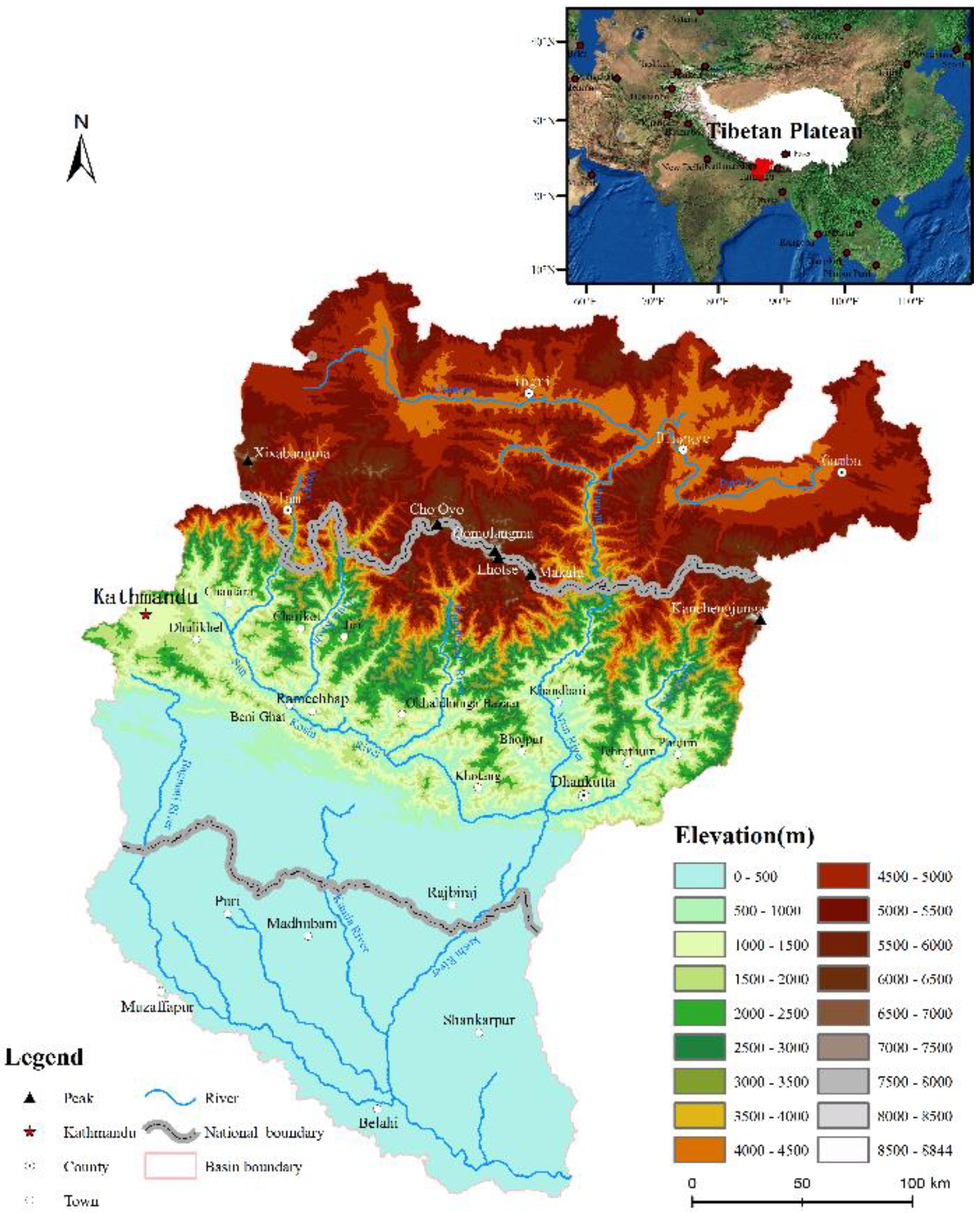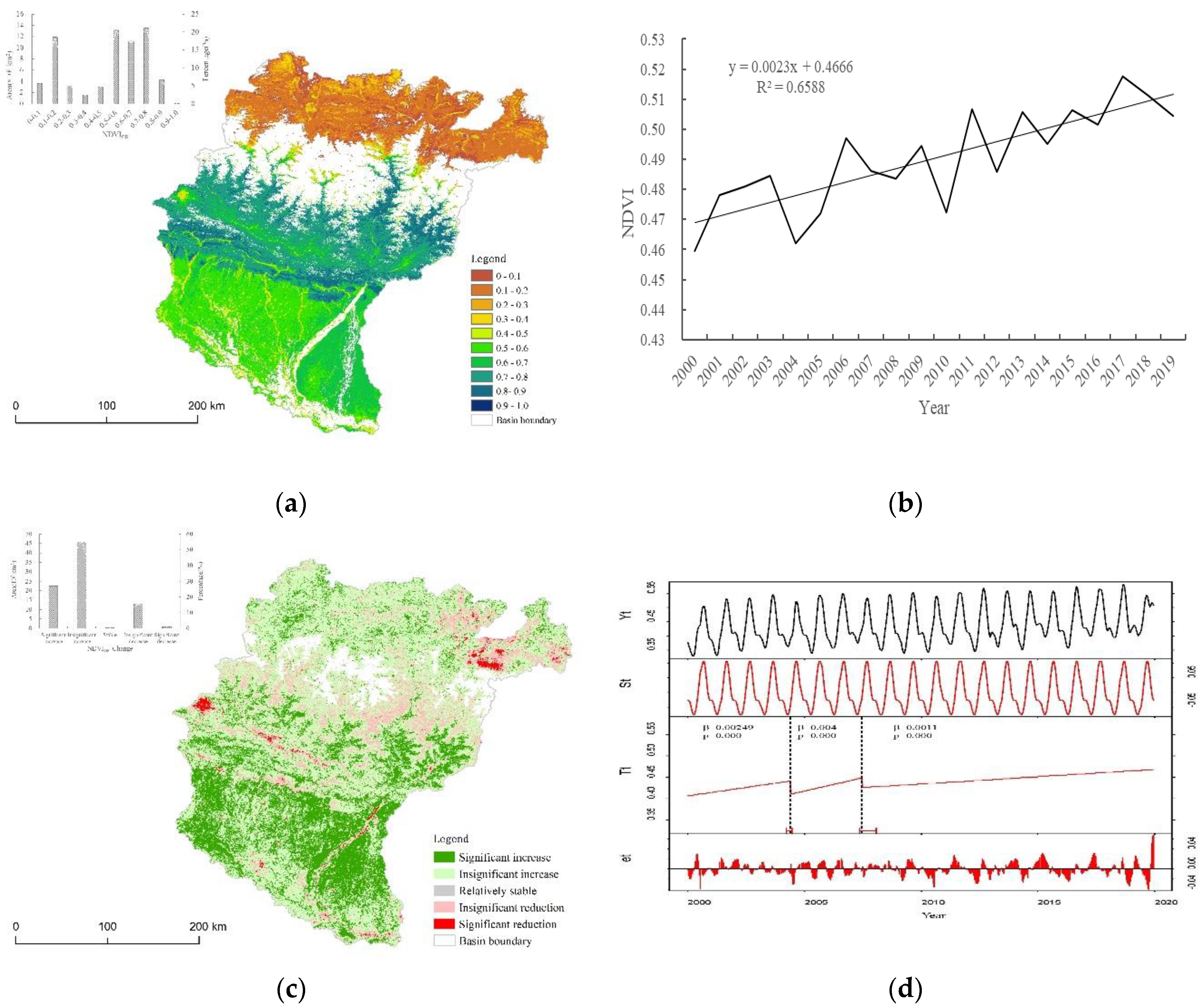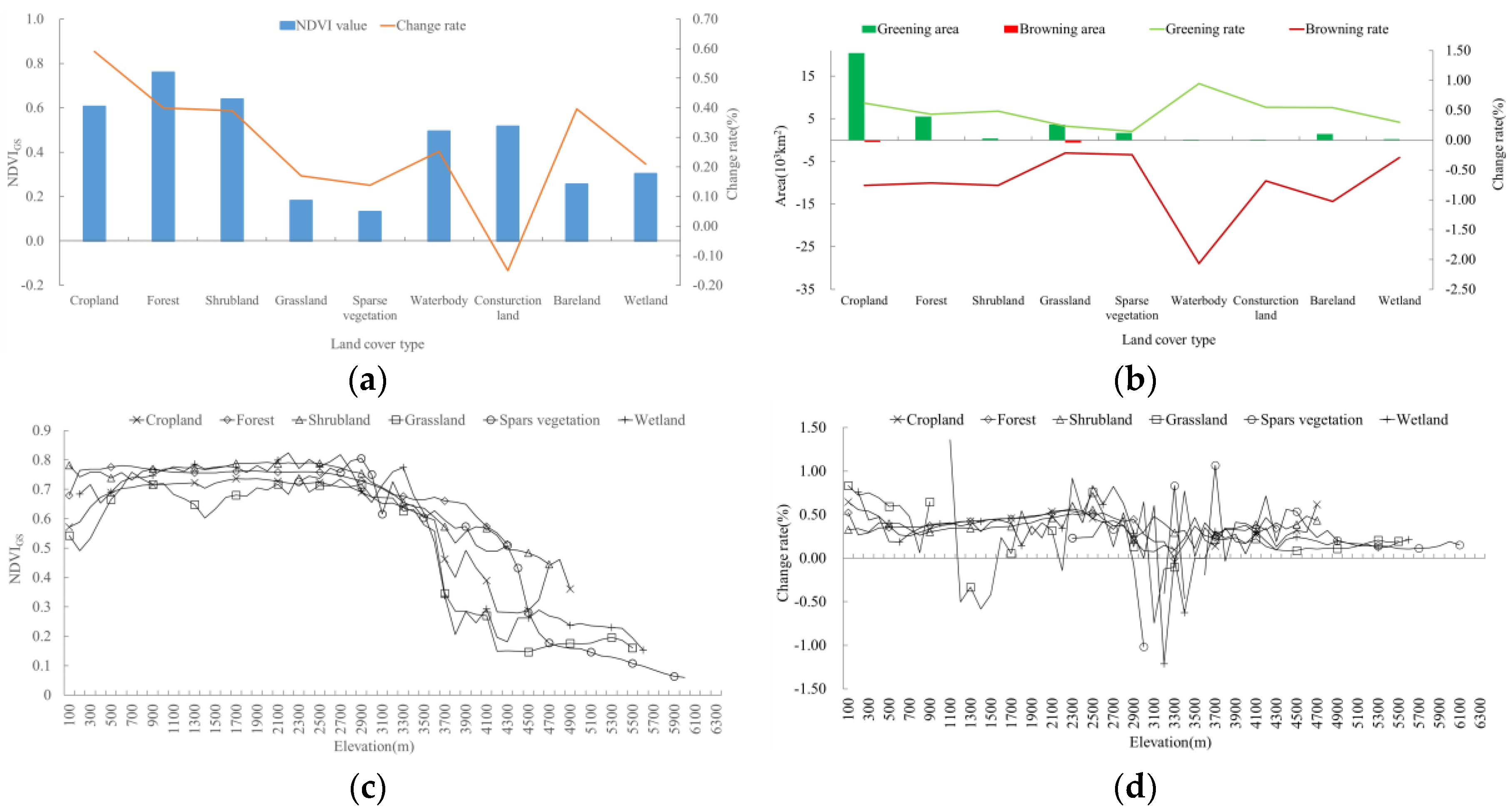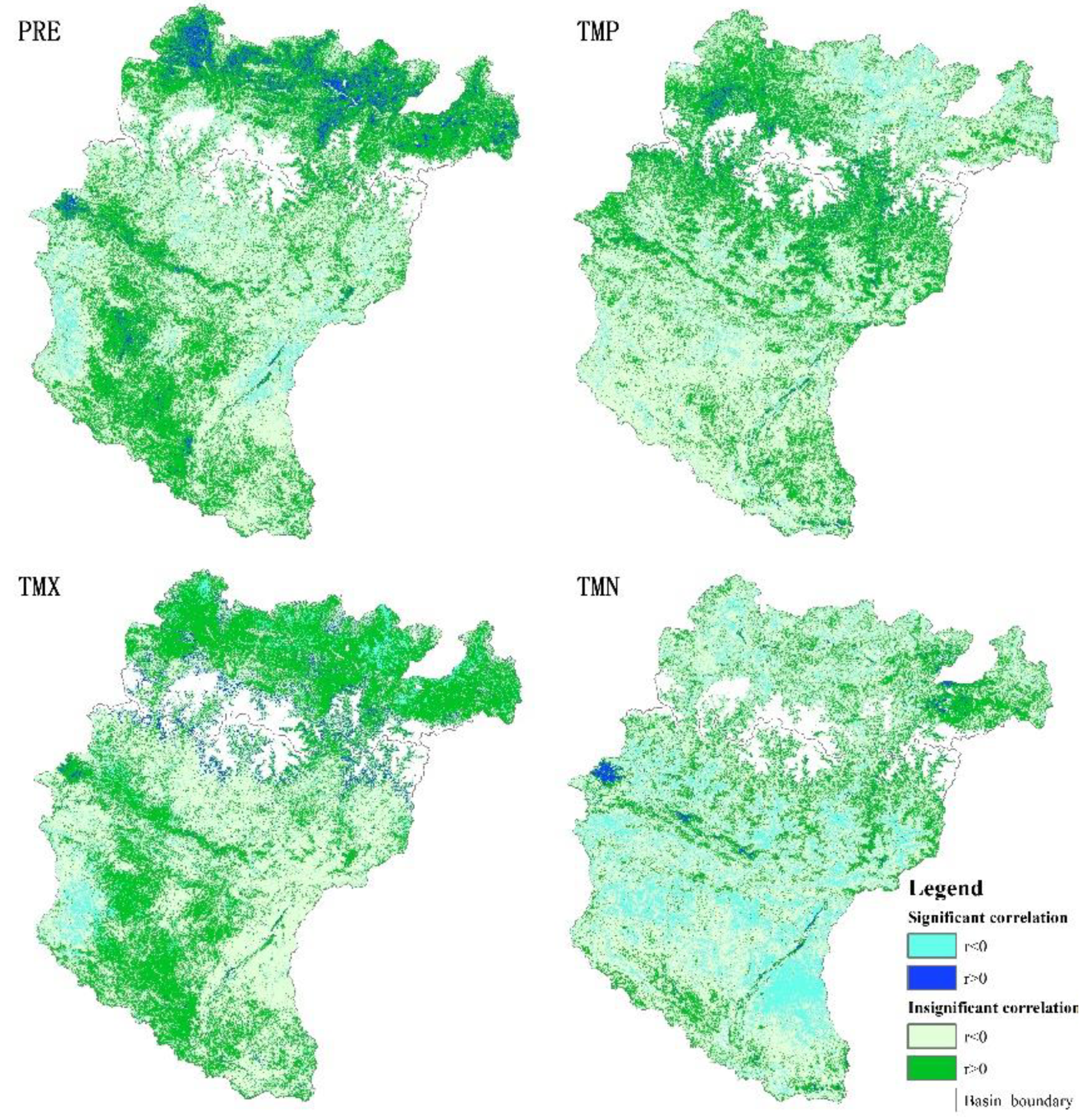Vegetation Changes and Their Response to Global Change Based on NDVI in the Koshi River Basin of Central Himalayas Since 2000
Abstract
1. Introduction
2. Materials and Methods
2.1. Study Area
2.2. Data and Sources
2.3. Methods
2.3.1. Analysis of Linear Time Trend and Turning Points of MODIS NDVI
2.3.2. Correlation between NDVI and Climate Variables
3. Results
3.1. Spatio-Temporal Change in NDVIGS from 2000–2018 and the Turning Points
3.2. Variations in NDVIGS along Elevation Gradient
3.3. Variation in NDVIGS with Land Cover Type
3.4. Correlation between Trends of NDVIGS and Climate Factors
Correlation between Trend of NDVIGS and Climate Change
4. Discussion
4.1. Trends of Temporal and Spatial Changes in NDVIGS
4.2. Response in Terms of NDVIGS to Climate Change and Human Activities
5. Conclusions
Author Contributions
Funding
Acknowledgments
Conflicts of Interest
References
- Zhao, L.; Dai, A.; Dong, B. Changes in global vegetation activity and its driving factors during 1982–2013. Agric. For. Meteorol. 2018, 249, 198–209. [Google Scholar] [CrossRef]
- de Jong, R.; Schaepman, M.E.; Furrer, R.; de Bruin, S.; Verburg, P.H. Spatial relationship between climatologies and changes in global vegetation activity. Glob. Chang. Biol. 2013, 19, 1953–1964. [Google Scholar] [CrossRef]
- Guo, L.; Wu, S.; Zhao, D.; Yin, Y.; Leng, G.; Zhang, Q. NDVI-Based Vegetation Change in Inner Mongolia from 1982 to 2006 and Its Relationship to Climate at the Biome Scale. Adv. Meteorol. 2014, 2014, 692068. [Google Scholar] [CrossRef]
- Alam, M.S.; Lamb, D.W.; Rahman, M.M. A refined method for rapidly determining the relationship between canopy NDVI and the pasture evapotranspiration coefficient. Comput. Electron. Agric. 2018, 147, 12–17. [Google Scholar] [CrossRef]
- Myneni, R.B.; Keeling, C.D.; Tucker, C.J.; Asrar, G.; Nemani, R.R. Increased plant growth in the northern high latitudes from 1981 to 1991. Nature 1997, 386, 698–702. [Google Scholar] [CrossRef]
- Fan, L.; Gao, Y.; Brück, H.; Bernhofer, C. Investigating the relationship between NDVI and LAI in semi-arid grassland in Inner Mongolia using in-situ measurements. Theor. Appl. Climatol. 2009. [Google Scholar] [CrossRef]
- Nemani, R.R.; Keeling, C.D.; Hashimoto, H.; Jolly, W.M.; Piper, S.C.; Tucker, C.J.; Myneni, R.B.; Running, S.W. Climate-Driven Increases in Global Terrestrial Net Primary Production from 1982 to 1999. Science 2003. [Google Scholar] [CrossRef]
- Huang, X.; Zhang, T.; Yi, G.; He, D.; Zhou, X.; Li, J.; Bie, X.; Miao, J. Dynamic Changes of NDVI in the Growing Season of the Tibetan Plateau During the Past 17 Years and Its Response to Climate Change. Int. J. Environ. Res. Public Health 2019, 16, 3452. [Google Scholar] [CrossRef]
- Jackson, R.B.; Randerson, J.T.; Canadell, J.G.; Anderson, R.G.; Avissar, R.; Baldocchi, D.D.; Bonan, G.B.; Caldeira, K.; Diffenbaugh, N.S.; Field, C.B. Protecting climate with forests. Environ. Res. Lett. 2008, 3, 269. [Google Scholar] [CrossRef]
- Anderson, R.G.; Canadell, J.G.; Randerson, J.T.; Jackson, R.B.; Hungate, B.A.; Baldocchi, D.D.; Ban-Weiss, G.A.; Bonan, G.B.; Caldeira, K.; Cao, L.; et al. Biophysical considerations in forestry for climate protection. Front. Ecol. Environ. 2011, 9, 174–182. [Google Scholar] [CrossRef]
- Xu, G.; Zhang, H.; Chen, B.; Zhang, H.; Innes, J.; Wang, G.; Yan, J.; Zheng, Y.; Zhu, Z.; Myneni, R. Changes in Vegetation Growth Dynamics and Relations with Climate over China’s Landmass from 1982 to 2011. Remote Sens 2014, 6, 3263–3283. [Google Scholar] [CrossRef]
- de Jong, R.; Verbesselt, J.; Schaepman, M.E.; de Bruin, S. Trend changes in global greening and browning: Contribution of short-term trends to longer-term change. Glob. Chang. Biol. 2012, 18, 642–655. [Google Scholar] [CrossRef]
- Zhang, Y.; Ye, W.M.; Chen, B.; Chen, Y.G.; Ye, B. Desiccation of NaCl-contaminated soil of earthen heritages in the Site of Yar City, northwest China. Appl. Clay. Sci. 2016, 599–600, 1–10. [Google Scholar] [CrossRef]
- Mishra, N.B.; Mainali, K.P. Greening and browning of the Himalaya: Spatial patterns and the role of climatic change and human drivers. Sci. Total Environ. 2017, 599–600, 326–339. [Google Scholar] [CrossRef]
- Zhang, Y.; Gao, J.; Liu, L.; Wang, Z.; Ding, M.; Yang, X. NDVI-based vegetation changes and their responses to climate change from 1982 to 2011: A case study in the Koshi River Basin in the middle Himalayas. Glob. Planet Chang. 2013, 108, 139–148. [Google Scholar] [CrossRef]
- Kalisa, W.; Igbawua, T.; Henchiri, M.; Ali, S.; Zhang, S.; Bai, Y.; Zhang, J. Assessment of climate impact on vegetation dynamics over East Africa from 1982 to 2015. Sci. Rep. 2019, 9, 1–20. [Google Scholar] [CrossRef]
- Bagherzadeh, A.; Hoseini, A.V.; Totmaj, L.H. The effects of climate change on normalized difference vegetation index (NDVI) in the Northeast of Iran. Modeling Earth Syst. Environ. 2020, 6, 671–683. [Google Scholar] [CrossRef]
- Zhang, Y.; Liu, L.; Nie, Y.; Zhang, J.; Zhang, X. Land cover mapping in the Qomolangma (Everest) national nature preserve. In Land Use & Land Cover Change and the Climate Change Adaptation in the Tibetan Plateau; Zhang, Y., Ed.; Meteorological Press: Beijing, China, 2012; pp. 129–158. [Google Scholar]
- Zhang, Y.; Liu, L.; Wang, Z. HKKH Project Final Report (Internal); Institute of Geographic Sciences and Natural Resources Research, CAS: Beijing, China, 2009. [Google Scholar]
- Jiang, W.; Yuan, L.; Wang, W.; Cao, R.; Zhang, Y.; Shen, W. Spatio-temporal analysis of vegetation variation in the Yellow River Basin. Ecol. Indic. 2015, 51, 117–126. [Google Scholar] [CrossRef]
- Sun, B.; Li, Z.; Gao, Z.; Guo, Z.; Wang, B.; Hu, X.; Bai, L. Grassland degradation and restoration monitoring and driving forces analysis based on long time-series remote sensing data in Xilin Gol League. Acta Ecol. Sin. 2017, 37, 219–228. [Google Scholar] [CrossRef]
- Liu, Q.; Wang, X.; Zhang, Y.; Zhang, H.; Li, L. Vegetation Degradation and Its Driving Factors in the Farming–Pastoral Ecotone over the Countries along Belt and Road Initiative. Sustainability 2019, 11, 1590. [Google Scholar] [CrossRef]
- Verbesselt, J.; Hyndman, R.; Zeileis, A.; Culvenor, D. Phenological change detection while accounting for abrupt and gradual trends in satellite image time series. Remote Sens. Environ. 2010, 114, 2970–2980. [Google Scholar] [CrossRef]
- Wang, F.; Zhao, G.; Mu, X.; Gao, P.; Sun, W. Regime Shift Identification of Runoff and Sediment Loads in the Yellow River Basin, China. Water Suit 2014, 6, 3012–3032. [Google Scholar] [CrossRef]
- Wand, Y.; Li, N.; Zhang, Z.; Zhang, J. BFAST—A New Method to Analyze Change of Climate Extremes. J. Catastrophol. 2016, 31, 196–199. [Google Scholar]
- Ding, M.; Li, L.; Nie, Y.; Chen, Q.; Zhang, Y. Spatio-temporal variation of spring phenology in Tibetan Plateau and its linkage to climate change from 1982 to 2012. J. Mt. Sci. 2016, 13, 83–94. [Google Scholar] [CrossRef]
- Wang, X.; Wang, T.; Liu, D.; Guo, H.; Huang, H.; Zhao, Y. Moisture-induced greening of the South Asia over the past three decades. Glob. Chang. Biol. 2017, 23, 4995–5005. [Google Scholar] [CrossRef] [PubMed]
- Han, B.; Zhou, B.; Yan, Y.; Shi, S.; Zhao, H.; Niu, D.; Fu, H. Analysis of Vegetation Coverage Change and Its Driving Factors over Tibetan Plateau from 2000 to 2008. Acta Agrestia Sin. 2019, 27, 1651–1658. [Google Scholar]
- Liu, S.; Cheng, F.; Dong, S.; Zhao, H.; Hou, X.; Wu, X. Spatiotemporal dynamics of grassland aboveground biomass on the Qinghai-Tibet Plateau based on validated MODIS NDVI. Sci. Rep. 2017, 7, 4182. [Google Scholar] [CrossRef]
- Chen, C.; Park, T.; Wang, X.; Piao, S.; Xu, B.; Chaturvedi, R.K.; Fuchs, R.; Brovkin, V.; Ciais, P.; Fensholt, R.; et al. China and India lead in greening of the world through land-use management. Nat. Sustain. 2019, 2, 122–129. [Google Scholar] [CrossRef]
- Jiang, L.; Jiapaer, G.; Bao, A.; Guo, H.; Ndayisaba, F. Vegetation dynamics and responses to climate change and human activities in Central Asia. Sci. Total Environ. 2017, 599–600, 967–980. [Google Scholar] [CrossRef]
- Ding, M.; Zhang, Y.; Liu, L.; Zhang, W.; Wang, Z.; Bai, W. The relationship between NDVI and precipitation on the Tibetan Plateau. J. Geogr. Sci. 2007, 17, 259–268. [Google Scholar] [CrossRef]
- Piao, S.; Friedlingstein, P.; Ciais, P.; Zhou, L.; Chen, A. Effect of climate and CO2 changes on the greening of the Northern Hemisphere over the past two decades. Geophys. Res. Lett. 2006, 33, 265–288. [Google Scholar] [CrossRef]
- Li, Z.; Huffman, T.; Mcconkey, B.; Townley-Smith, L. Monitoring and modeling spatial and temporal patterns of grassland dynamics using time-series MODIS NDVI with climate and stocking data. Remote Sens. Environ. 2013, 138, 232–244. [Google Scholar] [CrossRef]
- Wessels, K.J.; Prince, S.D.; Frost, P.E.; Zyl, D.V. Assessing the effects of human-induced land degradation in the former homelands of northern South Africa with a 1 km AVHRR NDVI time-series. Remote Sens. Environ. 2004, 91, 47–67. [Google Scholar] [CrossRef]
- Zhang, Y.; Qi, W.; Zhou, C.; Ding, M.; Liu, L.; Gao, J.; Bai, W.; Wang, Z.; Zheng, D. Spatial and temporal variability in the net primary production of alpine grassland on the Tibetan Plateau since 1982. J. Geogr. Sci. 2014, 24, 269–287. [Google Scholar] [CrossRef]
- Li, Z.; Wu, R.; Ma, Y. Impact of climate change and human activities on vegetation productivity in the Three-River Headwaters. J. Glaciol. Geocryol. 2016, 38, 804–810. [Google Scholar]
- Fabricante, I.; Oesterheld, M.; Paruelo, J.M. Annual and seasonal variation of NDVI explained by current and previous precipitation across Northern Patagonia. J. Arid Environ. 2009, 73, 745–753. [Google Scholar] [CrossRef]
- Zhang, J.; Dong, W.; Fu, C.; Wu, L. The influence of vegetation cover on summer precipitation in China: A statistical analysis of NDVI and climate data. Adv. Atmos. Sci. 2003, 20, 1002–1006. [Google Scholar]
- Immerzee, W.; Roberto, Q.; De, J. Understanding precipitation patterns and land use interaction in Tibet using harmonic analysis of SPOT VGT-S10 NDVI time series. Int. J. Remote Sens. 2005, 26, 2281–2296. [Google Scholar] [CrossRef]
- Wang, T.; Kou, X.; Xiong, Y.; Mou, P.U.; Wu, J.; Ge, J. Temporal and spatial patterns of NDVI and their relationship to precipitation in the Loess Plateau of China. Int. J. Remote Sens. 2010, 31, 1943–1958. [Google Scholar] [CrossRef]
- Li, L.; Zhang, Y.; Liu, L.; Wu, J.; Wang, Z.; Li, S.; Zhang, H.; Zu, J.; Ding, M.; Paudel, B. Spatiotemporal Patterns of Vegetation Greenness Change and Associated Climatic and Anthropogenic Drivers on the Tibetan Plateau during 2000–2015. Remote Sens. 2018, 10, 1525. [Google Scholar] [CrossRef]
- Gao, J.; Zhang, Y.; Liu, L.; Wang, Z. Climate change as the major driver of alpine grasslands expansion and contraction: A case study in the Mt. Qomolangma (Everest) National Nature Preserve, southern Tibetan Plateau. Quatern Int. 2014, 336, 108–116. [Google Scholar] [CrossRef]
- Qi, W.; Bai, W.; Zhang, Y.; Wu, X.; Li, L.; Ding, M.; Zhou, C. Effects of ecological engineering on net primary production in the Chang Tang and Sanjiangyuan national nature reserves on the Tibetan Plateau. Biodivers. Sci. 2016, 24, 7–15. [Google Scholar] [CrossRef]
- Sun, H.; Zheng, D.; Yao, T.; Zhang, Y. Protection and Construction of the National Ecological Security Shelter Zone on Tibetan Plateau. Acta Geogr. Sin. 2012, 67, 3–12. [Google Scholar]
- Zhang, Y.; Wu, X.; Qi, W.; Li, S.; Bai, W. Characteristics and protection effectiveness of nature reserves on the Tibetan Plateau, China. Resour. Sci. 2015, 7, 1455–1464. [Google Scholar]
- Su, X.; Dong, S.; Liu, S.; Yu, L.; Zhao, H. Changes in rangeland cover associated with livestock grazing in Altun National Nature Reserve, northwest Qinghai-Tibetan Plateau. Rangel. J. 2015. [Google Scholar] [CrossRef]
- Zhang, Y.; Hu, Z.; Qi, W.; Wu, X.; Bai, W.; Li, L.; Ding, M.; Li, L.; Liu, L.; Wang, Z.; et al. Assessment of effectiveness of nature reserves on the Tibetan Plateau based on net primary production and the large sample comparison method. J. Geogr. Sci. 2016, 1, 27–44. [Google Scholar] [CrossRef]
- Chandra, B.R. Economic impact of community forestry in Nepal: A case of mid-hill districts of Nepal. Econ. J. Dev. Issues 2012, 13. [Google Scholar] [CrossRef]
- Ito, K.; Oura, Y.; Takeya, H.; Hattori, S.; Kitagawa, K.; Paudel, D.; Paudel, G. The influence of NGO involvement on local people’s perception of forest management: A case study of community forestry in Nepal. J. For. Res. 2017. [Google Scholar] [CrossRef]
- Mishra, S.; Gopikrishna, S.R. Nutrient Based Subsidy (NBS) & Support Systems for Ecological Fertilization in Indian Agriculture. Comput. Digit. Tech. IET 2010, 5, 86–94. [Google Scholar]
- Patel, S.K.; Verma, P.; Shankar Singh, G. Agricultural growth and land use land cover change in peri-urban India. Environ. Monit. Assess 2019, 191, 600. [Google Scholar] [CrossRef]
- Pani, A.; Mishra, P. Hapa irrigation for promoting sustainable agricultural intensification: Experience from Bankura district of India. GeoJournal 2019, 1–24. [Google Scholar] [CrossRef]
- Bhaduri, A.; Amarasinghe, U.; Shah, T. An analysis of groundwater irrigation expansion in India. Int. J. Environ. Waste Manag. 2012, 9, 372. [Google Scholar] [CrossRef]
- Prathyusha, K.; Sowmya, B.G.; Sreenivasa, R.K. A Real-Time Irrigation Control System for Precision Agriculture Using WSN in Indian Agricultural Sectors. Eng. Appl. IJCSEA 2013, 3, 75–80. [Google Scholar]
- Singh, O.; Kasana, A.; Sharma, T. Groundwater irrigation market patterns and practices over an agriculturally developed province of north-west India. GeoJournal 2020, 85, 703–729. [Google Scholar] [CrossRef]
- Gautam, A.P.; Shivakoti, G.P.; Webb, E.L. A review of forest policies, institutions, and changes in the resource condition in Nepal. Int. For. Rev. 2004, 6, 136–148. [Google Scholar] [CrossRef]
- Singh, O.; Kumar, D. Evaluating the influence of watershed characteristics on flood vulnerability of Markanda River basin in north-west India. Nat. Hazards 2019, 96, 247–268. [Google Scholar] [CrossRef]
- Katuwal, H.B.; Pradhan, N.M.B.; Thakuri, J.J.; Bhusal, K.P.; Aryal, P.C.; Thapa, I. Effect of Urbanization and Seasonality in Bird Communities of Kathmandu Valley, Nepal. Proc. Zool. Soc. 2018, 71, 103–113. [Google Scholar] [CrossRef]
- Bhagawat, R.; Zhang, L.; Nigel, S.; Sean, S.; Sushila, R. Urban Expansion Occurred at the Expense of Agricultural Lands in the Tarai Region of Nepal from 1989 to 2016. Sustainability 2018, 10, 1341. [Google Scholar]
- Baniya, B.; Qiuhong, T. Vegetation dynamics in response to climate change based on satellite derived NDVI in Nepal. EGU Gen. Assem. Conf. Abstr. 2018, 20, 91. [Google Scholar]
- Baniya, B.; Tang, Q.; Huang, Z.; Sun, S.; Kua-Anan, T. Spatial and Temporal Variation of NDVI in Response to Climate Change and the Implication for Carbon Dynamics in Nepal. Forests 2018, 9, 329. [Google Scholar] [CrossRef]
- Zhang, L. Development and suggestion of Gangba sheep industry. Tibet J. Agric. Sci. 2018, 40, 1–3. [Google Scholar]
- Mao, Y.; Huang, Q.; Zhao, J. On the advantages and significance of developing forage planting in Tibetan agricultural areas. Res. Dev. 2016, 3, 172–176. [Google Scholar]
- Cang, M. Space Distribution status of grassland resources of Gangba in Tibet based on 3S technonologies. Grassl. Pratacult. 2014, 26, 23–26. [Google Scholar]
- Jiang, H. Study on county tourism planning in Xigaze area of Tibet—A case study of Gamba county. Master’s Thesis, Sichuan Normal University, Chengdu, China, 2014. Available online: http://www.wanfangdata.com.cn/details/detail.do?_type=degree&id=Y2552513 (accessed on 26 June 2020).
- Anderson, K.; Fawcett, D.; Cugulliere, A.; Benford, S.; Jones, D.; Leng, R. Vegetation expansion in the subnival Hindu Kush Himalaya. Glob. Chang. Biol. 2020, 26, 1608–1625. [Google Scholar] [CrossRef]





© 2020 by the authors. Licensee MDPI, Basel, Switzerland. This article is an open access article distributed under the terms and conditions of the Creative Commons Attribution (CC BY) license (http://creativecommons.org/licenses/by/4.0/).
Share and Cite
Wu, X.; Sun, X.; Wang, Z.; Zhang, Y.; Liu, Q.; Zhang, B.; Paudel, B.; Xie, F. Vegetation Changes and Their Response to Global Change Based on NDVI in the Koshi River Basin of Central Himalayas Since 2000. Sustainability 2020, 12, 6644. https://doi.org/10.3390/su12166644
Wu X, Sun X, Wang Z, Zhang Y, Liu Q, Zhang B, Paudel B, Xie F. Vegetation Changes and Their Response to Global Change Based on NDVI in the Koshi River Basin of Central Himalayas Since 2000. Sustainability. 2020; 12(16):6644. https://doi.org/10.3390/su12166644
Chicago/Turabian StyleWu, Xue, Xiaomin Sun, Zhaofeng Wang, Yili Zhang, Qionghuan Liu, Binghua Zhang, Basanta Paudel, and Fangdi Xie. 2020. "Vegetation Changes and Their Response to Global Change Based on NDVI in the Koshi River Basin of Central Himalayas Since 2000" Sustainability 12, no. 16: 6644. https://doi.org/10.3390/su12166644
APA StyleWu, X., Sun, X., Wang, Z., Zhang, Y., Liu, Q., Zhang, B., Paudel, B., & Xie, F. (2020). Vegetation Changes and Their Response to Global Change Based on NDVI in the Koshi River Basin of Central Himalayas Since 2000. Sustainability, 12(16), 6644. https://doi.org/10.3390/su12166644





